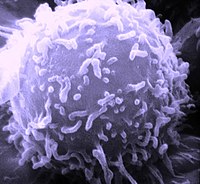
Photo from wikipedia
We explored changes in pregnancy-specific glycoprotein 9 (PSG9) levels in the serum of patients with preeclampsia and the effects and underlying mechanisms of PSG9 effects on calcium (Ca2+) homeostasis and… Click to show full abstract
We explored changes in pregnancy-specific glycoprotein 9 (PSG9) levels in the serum of patients with preeclampsia and the effects and underlying mechanisms of PSG9 effects on calcium (Ca2+) homeostasis and nitric oxide (NO) release in human umbilical vein endothelial cells (HUVECs). Western blotting was used to detect protein expression levels, and an NO fluorescence probe was used to examine NO production. Intracellular Ca2+ concentrations were measured using a Ca2+-sensitive fluorescent dye under a fluorescence microscope. Compared with those in healthy pregnant women, serum PSG9 levels were significantly decreased in patients with preeclampsia. PSG9 (0.1 μg/mL) treatment of HUVECs significantly enhanced the expression levels of store-operated calcium entry (SOCE) channel proteins Orai1 and Orai2, but not Orai3, and of endothelial nitric oxide synthase (eNOS) and NO production. Pretreatment with an inhibitor of SOCE (BTP2) abolished PSG9-enhanced Orai1, Orai2, and eNOS expression levels and NO production in HUVECs. The mechanisms underlying SOCE that were PSG9 enhanced in HUVECs appear to involve the Ca2+/eNOS/NO signaling pathway. These findings suggest that serum PSG9 levels may be a potential biomarker for monitoring the occurrence or development of preeclampsia in pregnancy and that PSG9 may be a potential therapeutic target for the treatment of preeclampsia.
Journal Title: Diagnostics
Year Published: 2023
Link to full text (if available)
Share on Social Media: Sign Up to like & get
recommendations!